Religion in the Philippines (2020 census)
Catholic Church (78.8%) Iglesia ni Cristo (2.6%) Aglipay (1.4%) Seventh-day Adventist Church (0.8%) Other Christians (1.7%) Islam (6.4%) Other religious affiliation (8.2%)
| This article is part of a series on the |
| Culture of the Philippines |
|---|
 |
| Society |
| Arts and Literature |
| History and Tradition |
| Symbols |
|
Philippines portal |
Christianity is the predominant religion in the Philippines, with the Catholic Church being its largest denomination. Sizeable minorities adhering to Islam, Dharmic religions (Buddhism and Hinduism), and indigenous Philippine folk religions (Anito or Anitism) are also present.
The country is secular and its constitution guarantees freedom of religion. Before the arrival of Spanish missionaries, the various ethnic groups residing in the territory of modern-day Philippines practiced a variety of faiths.
Overview
According to the 2020 census, almost 88% of the population is Christian; about 79% belong to the Catholic Church while about 9% belong to Protestantism and other denominations such as Iglesia ni Cristo, Seventh-day Adventist Church, Church of Jesus Christ of Latter-Day Saints, Philippine Independent Church, Jehovah's Witnesses, Apostolic Catholic Church, United Church of Christ in the Philippines, Members Church of God International, and Pentecostals.
Indigenous Philippine folk religions (collectively referred to as Anitism or Bathalism), the traditional religion of Filipinos which predates Philippine Christianity and Islam, is practiced by an estimated 2% of the population, made up of many indigenous peoples, tribal groups, and people who have reverted into traditional religions from Catholic/Christian or Islamic religions. These religions are often syncretized with Christianity and Islam. Buddhism is practiced by 0.04% of the Philippine population by the Japanese-Filipino community, and, together with Taoism and Chinese folk religion, is also dominant in Chinese communities. There are also smaller number of followers of Sikhism, Hinduism as well. Irreligion in the Philippines is very low, with 0.04% of the Philippine population self-reporting in 2020 as having no religion.
According to the 2015 census, Evangelicals comprised 2% of the population. It is particularly strong among American and Korean communities, Northern Luzon especially in Cordillera Administrative Region, Southern Mindanao and many other tribal groups in the Philippines. Protestants both mainline and evangelical have gained significant annual growth rate up to 10% since 1910 to 2015.
About 6.4% of the population of the Philippines is Muslim as of 2020, making Islam the second largest religion in the country. The majority of Muslims live in parts of Mindanao, Palawan, and the Sulu Archipelago – an area known as Bangsamoro or the Moro region. Some have migrated into urban and rural areas in different parts of the country, and are highly visible in and around Metro Manila (especially in the 'Muslim Town' district of Quiapo in Manila, Baclaran in Parañaque, parts of Las Piñas, and Maharlika in Pasig), Metro Cebu, Baguio and the Calabarzon region (notably in urbanized towns and cities in Cavite, Laguna, and Batangas). Most Muslim Filipinos practice Sunni Islam according to the Shafi'i school. There are some Ahmadiyya Muslims in the country.
Freedom of religion
Freedom of religion in the Philippines is guaranteed by the Constitution under Section 5 of Article III (Bill of Rights), which states that "No law shall be made respecting an establishment of religion, or prohibiting the free exercise thereof. The free exercise and enjoyment of religious profession and worship, without discrimination or preference, shall forever be allowed. No religious test shall be required for the exercise of civil or political rights". In 2024, Freedom House gave the country a 4 out of 4 score for religious freedom.
Demographics

| Religious majority according to the 2020 Census | |
| Christians: | Muslims: |
|---|---|
| above 50% | above 50% |
| above 70% | above 70% |
| above 85% | above 85% |
| above 95% | above 95% |
The Philippine Statistics Authority reported in February 2023 that, based on the 2020 census, 78.81% of the total Filipino population were Catholics, 10.8%- 11% were Protestants and 6.42% were Muslims.
| Affiliation | Number | Percentage | ||
|---|---|---|---|---|
| Roman Catholic | 85,645,362 | 78.8% | ||
| Islam | 6,981,710 | 6.4% | ||
| Iglesia ni Cristo | 2,806,524 | 2.6% | ||
| Philippine Independent Church | 1,458,992 | 1.4% | ||
| Seventh-day Adventist | 862,725 | 0.8% | ||
| Bible Baptist Church | 540,364 | 0.5% | ||
| United Church of Christ in the Philippines | 470,792 | 0.4% | ||
| Jehovah's Witnesses | 457,245 | 0.4% | ||
| Church of Christ | 429,921 | 0.4% | ||
| Other religious affiliations | 8,954,291 | 8.2% | ||
| None | 43,931 | 0% | ||
| Not reported | 15,186 | 0% | ||
| Total | 108,667,043 | 100% | ||
| Source: Philippine Statistics Authority | ||||
Christianity
Main article: Christianity in the Philippines See also: List of Christian denominations in the Philippines
Christianity arrived in the Philippines with the landing of Ferdinand Magellan in 1521. In 1543, Spanish explorer Ruy López de Villalobos named the archipelago Las Islas Filipinas in honor of Philip II of Spain, who was then Prince of Girona and of Asturias under his father, Charles V, Holy Roman Emperor who, as Charles I, was also King of Spain. Missionary activity during the country's colonial rule by Spain and the United States led the transformation of the Philippines into the first and then, along with East Timor, one of two predominantly Catholic nations in East Asia, with approximately 88.66% of the population belonging to the Christian faith.
Catholicism
Main article: Catholic Church in the Philippines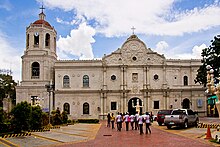
Catholicism (Filipino: Katolisismo; Spanish: Catolicismo) is the predominant religion and the largest Christian denomination in the Philippines comprising 78.8% of the population (or 85,645,362 million adherents) in 2020. It served as the country's state religion over most of the archipelago during the Spanish colonial period, under the Spanish Constitution of 876. Spanish efforts to convert many on the islands were aided by the lack of a significant central authority, and by friars who learnt local languages to preach. Some traditional animistic practices blended with the new faith. Catholicism's status as state religion continued under the short-lived Malolos Republic. The American colonial government established a policy of separation of church and state, eventually ending prospects of establishing a state religion in the Philippines.
The Catholic Church has great influence on Philippine society and politics. It was instrumental in rallying public support for the bloodless People Power Revolution of 1986. Then-Archbishop of Manila and de facto Primate of the Philippines, Cardinal Jaime Sin appealed to the public via radio to congregate along Epifanio de los Santos Avenue in support of rebel forces against the dictatorship of President Ferdinand E. Marcos. Some seven million people responded to the call between February 22–25, and the non-violent protests successfully forced Marcos and his family out of power and into exile in Hawaii.
Several Catholic holidays are culturally important as family occasions, and are observed in the civil calendar. Chief among these are Christmas, which includes celebrations of the civil New Year, and the more solemn Holy Week, which may occur in March or April. Every November, Filipino families celebrate All Saints' Day and All Souls' Day as a single holiday in honour of the saints and the dead, visiting and cleaning ancestral graves, offering prayers, and feasting. As of 2018, Feast of the Immaculate Conception on December 8 was added as a special non-working holiday.
Philippine Independent Church
 Iglesia Filipina Independiente Parish of Our Lady of Guidance in Magallanes, Cavite
Iglesia Filipina Independiente Parish of Our Lady of Guidance in Magallanes, Cavite St. Michael the Archangel Parish of Binakayan of the Iglesia Filipina Independiente in Kawit
Main article: Philippine Independent Church
St. Michael the Archangel Parish of Binakayan of the Iglesia Filipina Independiente in Kawit
Main article: Philippine Independent Church
The Philippine Independent Church (officially in Philippine Spanish: Iglesia Filipina Independiente, IFI; colloquially known as the Aglipayan Church) is an independent Christian denomination in the form of a nationalist church in the Philippines. Its revolutionary nationalist schism from the Roman Catholic Church was proclaimed in 1902 by the members of the Unión Obrera Democrática Filipina due to the mistreatment towards the Filipinos by Spanish priests and partly influenced by the execution of nationalist José Rizal under Spanish colonial rule.
Isabelo de los Reyes was one of the initiators of the separation, and suggested that former Roman Catholic priest Gregorio Aglipay be the head of the church. It is also known as the "Aglipayan Church" after its first Obispo Maximo, Gregorio Aglipay.
Commonly shared beliefs in the Aglipayan Church are the rejection of the Apostolic Succession solely to the Petrine Papacy, the acceptance of priestly ordination of women, the free option of clerical celibacy, the tolerance to join Freemasonry groups, and the advocacy of contraception and same-sex civil rights among its members. Many saints canonised by Rome after the schism are also not officially recognised by the Aglipayan church and its members, but they recognise the popes that have been universally canonised as saints before the schism.
In 2020, the Philippine Independent Church had around 1,458,992 adherents (1.4% of the Philippine population). Aglipayans in the Philippines claim to number at least 6 to 8 million members, with most from the northern part of Luzon, especially in the Ilocos Region and in the parts of Visayas like Antique, Iloilo and Guimaras provinces. Congregations are also found throughout the Philippine diaspora in North America, Europe, Middle East and Asia. With the exception of the Unitarian Iglesia ni Cristo, the church is the second-largest single Christian denomination in the country after the Roman Catholic Church (some 80.2% of the population). It has 48 dioceses plus the 2 dioceses outside the Philippines such as the Diocese of Tampa (USA) and the Diocese of Western USA, Western Canada, and the Pacific Islands. It has Fellowship congregations in the United Kingdom, United Arab Emirates, Hong Kong and Singapore. IFI is in full communion with the Anglican Churches and The Episcopal Church.
Iglesia ni Cristo
Main article: Iglesia ni Cristo
Iglesia ni Cristo (English: Church of Christ; Spanish: Iglesia de Cristo) is the largest entirely locally initiated religious organisation in the Philippines comprising roughly 2.6% of religious affiliation in the country. Felix Y. Manalo officially registered the church with the Philippine Government on July 27, 1914 and because of this, most publications refer to him as the founder of the church. Felix Manalo claimed that he was restoring the church of Christ that was lost for 2,000 years. He died on April 12, 1963, aged 76.
The Iglesia ni Cristo is known for its large evangelical missions. The largest of which was the Grand Evangelical Mission (GEM) which also occurred simultaneously on 19 sites across the country. In Manila site alone, more than 600,000 people attended the event. Other programs includes the Lingap sa Mamamayan (Aid to Humanity), The Kabayan Ko Kapatid Ko (My Countrymen, My Brethren) and various resettlement projects for affected individuals. The church has been embroiled in corruption scandals, as well as allegations of illegal detentions in 2015, leading to widespread protests. Issues about the idolization of the group's founder and the church establishment over the Bible have also surfaced, as well as the outcasting of members who question the leaders of the church.
Seventh-day Adventist Church
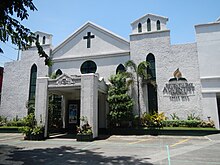
The Seventh-day Adventist Church (Filipino: Iglesia Adventista ng Ikapitong Araw; Spanish: Iglesia Adventista del Septimo Dia) is the fourth largest Christian denomination and fifth largest religious affiliation in the Philippines, behind Philippine Independent Church or Aglipay. The church was established in the Philippines in 1905. Robert Caldwell, a literature evangelist missionary, arrived in Manila on August 24 of that year and pioneered the literature ministry by selling books in the language people understand – Spanish. People bought books and spread the word to their friends. In 1906, the Philippine Mission was organized under the Asiatic Division with headquarters located in Shanghai, China.
The Seventh-day Adventist Church was co-founded by Ellen G. White, which is best known for its teaching that Saturday, the seventh day of the week, is the Sabbath, and that the second advent of Christ is imminent. Colloquially called Sabadístas by outsiders, Filipino Adventists numbered 862,725 as of 2020 with an annual membership growth rate of 5.6%. As of 2022, the Seventh-day Adventist Church has 5,358 churches in the Philippines. Numerous primary and secondary schools, colleges, and a university—notably, the Adventist University of the Philippines and Adventist International Institute of Advance Studies–were established to provide education to students as well as to assist in preaching and evangelization of the church in different parts of the country.
Jesus Miracle Crusade International Ministry
Main article: Jesus Miracle CrusadeThe Jesus Miracle Crusade International Ministry (JMCIM) is an apostolic Pentecostal religious group from the Philippines which believes in the gospel of Jesus Christ with signs, wonders, miracles and faith in God for healing. JMCIM was founded by evangelist Wilde E. Almeda on February 14, 1975.
Members Church of God International
Main article: Members Church of God International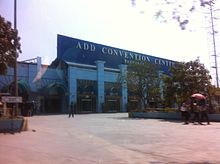
Members Church of God International (MCGI, Filipino: Mga Kaanib sa Iglesia ng Dios Internasyonal) is a religious organization popularly known through its Filipino television program, Ang Dating Daan (English Program "The Old Path"; in Spanish El Camino Antiguo; in Portuguese O Caminho Antigo). MCGI are one of the Christian majority in the Philippines with more than a million members internationally.
The church is known for their "Bible Expositions", where guests and members are given a chance to ask any biblical question to the "Overall Servant" Eliseo Soriano. He and his associates refute teachings of asked religions which are, according to Soriano, "not biblical" and discuss controversial passages. Besides general preaching, they also established charity works. Among these humanitarian services are The Legacy Continues Wish granting activity, MCGI Free Store, Free Meal and Free Potable Water; charity homes for the senior citizens and orphaned children and teenagers; transient homes; medical missions; full college scholarship; start-up capital for livelihood projects; vocational training for the differently-abled; free legal assistance; free bus, jeepney, and train rides for commuters and senior citizens, and; free Bibles for everyone. MCGI is now one of the major blood donor in the Philippines, as acknowledged and awarded by the Philippine National Red Cross' Jose Rizal Award, the highest honor given by PNRC.
Most Holy Church of God in Christ Jesus
The Most Holy Church of God in Christ Jesus (Filipino: Kabanalbanalang Iglesia ng Dios kay Kristo Hesus), is an independent Christian denomination officially registered in the Philippines by Teofilo D. Ora in May 1922. The church claims to restore the visible church founded in Jerusalem by Christ Jesus. It has spread to areas including California, Calgary, Dubai, and other Asian countries. According to the 2020 census, the church had 9,585 members in the Philippines.
The church was founded by Bishop Teofilo D. Ora in 1922. He, along with Avelino Santiago and Nicolas Perez, split off from the Iglesia ni Cristo (Church of Christ) in 1921. They initially called their church Iglesia Verdadera de Cristo Hesus (True Church of Christ Jesus). However, following a religious doctrine controversy, Nicolas Perez split off from the group and registered an offshoot called Iglesia ng Dios kay Kristo Hesus, Haligi at Suhay ng Katotohanan (Church of God in Christ Jesus, the Pillar and Support of the Truth). Teofilo D. Ora was bishop until his death in 1969. He was officially succeeded by Bishop Salvador C. Payawal who led the church until 1989. Subsequent bishops were Bishop Gamaliel T. Payawal (1989 to 2003) and Bishop Isagani N. Capistrano (2003–present). It was during Gamaliel Payawal's tenure when the church was renamed as Most Holy Church of God in Christ Jesus.
Apostolic Catholic Church
Main article: Apostolic Catholic Church (Philippines)
Apostolic Catholic Church (ACC; Filipino: Apostolika't Katolikang Simbahan) is an Independent Catholic denomination established in 1992 by John Florentine L. Teruel. The church started as a mainstream Catholic lay organization that was founded in Hermosa, Bataan in the early 1970s by Maria Virginia P. Leonzon Vda. De Teruel. In 1991 the organisation and the Roman Catholic Church had a schism; due to varying issues, it formally separated itself from the Roman Catholic Church, when John Florentine Teruel was consecrated as a patriarch and registered the church as a Protestant and Independent Catholic denomination.
As of 2020, the Apostolic Catholic Church has 54,543 members in the Philippines. The National Council of Churches in the Philippines reports that the Apostolic Catholic Church has more than 5 million members worldwide. The largest international congregations are in Japan, United States and Canada.
Orthodoxy
Main article: Philippine Orthodox ChurchOrthodoxy has been continuously present in the Philippines for more than 200 years. It is represented by two groups, by the Exarchate of the Philippines (a jurisdiction of the Ecumenical Patriarchate of Constantinople governed by the Orthodox Metropolitanate of Hong Kong and Southeast Asia), and by the Antiochian Orthodox Christian Mission in the Philippines (a jurisdiction of the Antiochian Orthodox Church governed by the Antiochian Orthodox Archdiocese of Australia, New Zealand, and All Oceania). In 1999, it was asserted that there were about 560 Orthodox church members in the Philippines.
Protestantism
Main article: Protestantism in the Philippines
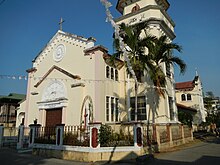

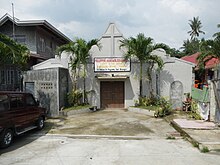
Protestantism arrived in the Philippines with the take-over of the islands by Americans at the turn of the 20th century. In 1898, Spain lost the Philippines to the United States. After a bitter fight for independence against its new occupiers, Filipinos surrendered and were again colonized. The arrival of Protestant American missionaries soon followed. As of 2015, Protestants comprised about 10%-15% of the population, with an annual growth rate of 10% since 1910 and constitute the largest Christian grouping after Catholicism. Protestants were 10.8% of the population in 2010. Protestant church organizations established in the Philippines during the 20th century include the following:
- Ang Iglesia Metodista sa Pilipinas (Methodist)
- Association of Fundamental Baptist Churches in the Philippines (Baptist/Evangelical)
- Awake International Ministries (Evangelical)
- Baptist Bible Fellowship in the Philippines (Baptist/Evangelical)
- Bread of Life Ministries International (Evangelical)
- Cathedral of Praise (Pentecostal)
- Christ's Commission Fellowship (Evangelical)
- Christ Living Epistle Ministries Inc. (Full Gospel/Pentecostal)
- Christian and Missionary Alliance Churches of the Philippines
- Church of God (Cleveland, Tennessee)
- Church of God in Christ (Memphis, Tennessee)
- Church of the Foursquare Gospel in the Philippines (Full Gospel/Pentecostal)
- Church of the Nazarene (Holiness movement)
- Citichurch Cebu (Pentecostal)
- City of God Celebration Church (Pentecostal)
- Conservative Baptist Association of the Philippines (Baptist)
- Convention in Visayas and Mindanao of Southern Baptist Churches (Baptist)
- Convention of Philippine Baptist Churches (Baptist)
- Day by Day Christian Ministries (Evangelical)
- Episcopal Church in the Philippines (Anglican)
- Every Nation Churches and Ministries (Pentecostal/Evangelical)
- Grace Christian Church of the Philippines
- Greenhills Christian Fellowship (Conservative Baptist)
- Heartland Covenant Church (formerly Jesus Cares Ministries)
- His Life Ministries (Non-Denominational)
- His Life City Church (Pentecostal)
- Iglesia Evangelica Metodista en las Islas Filipinas
- Iglesia Evangelica Unida de Cristo
- Jesus Flock Gateway Church (Full Gospel)
- Jesus Is Lord Church Worldwide (Full Gospel)
- Jesus Miracle Crusade International Ministry (Full Gospel)
- Jesus the Anointed One Church (Pentecostal)
- Jesus the Blessed Redeemer International Ministry (JBRIM)
- Lutheran Church in the Philippines (Lutheran)
- Luzon Convention of Southern Baptist Churches (Baptist)
- New Life Christian Center (Pentecostal)
- Pentecostal Global Ministries Full Gospel Church (Pentecostal)
- Pentecostal Missionary Church of Christ (4th Watch) (Pentecostal)
- Philippine Evangelical Holiness Churches
- Philippines General Council of the Assemblies of God
- Presbyterian Church of the Philippines
- Redeeming Grace Christian Centre
- Seventh-day Adventist Church
- The Salvation Army
- TEAM Ministries international
- The Blessed Word International Church (Evangelical)
- The United Methodist Church (Methodist)
- Union Church Manila
- Union Espiritista Cristiana de Filipinas (established on 1905)
- United Church of Christ in the Philippines (Congregationalist, Presbyterian, Disciples, United Brethren, Methodist)
- United Evangelical Church of the Philippines
- United Methodist Church
- Victory Christian Fellowship (Evangelical)
- Vineyard Christian Fellowship (Evangelical)
- Word for the World Christian Fellowship (Evangelical)
- Word of Life World Mission Church (Pentecostal)
- Words of Life Christian Ministries
The Church of Jesus Christ of Latter-day Saints
Main article: The Church of Jesus Christ of Latter-day Saints in the Philippines
The Church of Jesus Christ of Latter-day Saints (LDS Church) in the Philippines was founded during the Spanish-American War in 1898. Two men from Utah who were members of the United States artillery battery, and who were also set apart as missionaries by the Church before they left the United States, preached while stationed in the Philippines. Missionary work picked up after World War II, and in 1961 the Church was officially registered in the Philippines. In 1969, the Church had spread to eight major islands and had the highest number of baptisms of any area in the Church. Membership according to the church was 805,209 in 2019; the 2020 census counted 175,004. A temple was built in 1984 which is located in Manila, and a second temple was completed in Cebu City in 2010. By 2019, four more LDS temples had been announced, they are planned to be built in Urdaneta, Cagayan de Oro, Davao, as well as a second temple in the greater Manila area. As of 2024, a total of 10 temples were either operating, under construction, or announced within the country.
Other Christians
- The Bible Student movement, from which Jehovah's Witnesses later developed, was introduced to the Philippines in 1912, when the president of the Watch Tower Society, Charles Taze Russell, gave a talk at the former Manila Grand Opera House. In 1993, a Supreme Court case involving the Witnesses resulted in the reversal of an earlier 1959 Supreme Court decision and in upholding "the right of children of Jehovah's Witnesses to refrain from saluting the flag, reciting the pledge of allegiance, and singing the national anthem." As of 2021, there were officially 235,736 active members in the Philippines in 3,504 congregations nationwide. Their 2021 observance of the annual Memorial of Christ's death attracted an attendance of 739,439 in the country.
- The Kingdom of Jesus Christ, the Name Above Every Name was founded by pastor Apollo C. Quiboloy on September 1, 1985. Quiboloy claims to be the "Appointed" Son of God, that salvation is through him, that he is the residence of the God the Father and that he restores the Kingdom of God in the gentile settings.
- United Pentecostal Church International (Oneness) originated in the United States as an offshoot of the Pentecostal movements in the 1920s. The church is a proponent of the belief of modalism to describe God, and is non-trinitarian in its conception of God.
- Jesus Christ To God be the Glory (Friends Again) was founded by Luis Ruíz Santos in 1988.
- Churches of Christ (Churches of Christ 33 AD/the Stone-Campbellites) is a restorationist movement that distinctly believes in a set of steps or ways to attain salvation, among of which is prerequisite immersion baptism.
- Loyal Singles for Jesus Ministry, founded by EJ Tingey in 2018. He claims that true salvation is achieved by being loyal to God and women.
- True Jesus Church a "oneness" movement that started in the People's Republic of China.
- Jesus is Our Shield Worldwide Ministries (commonly known as Oras ng Himala, "Hour of Miracle") was founded by Renato D. Carillo, who claims to be the end-times apostle.
- Universal Church of the Kingdom of God (UCKG Help Center) was founded by Edir Macedo in 1977 in Brazil.
- Unification Church, founded by Sun Myung Moon in what is today South Korea.
Islam
Main article: Islam in the Philippines
Islam reached the Philippines in the 14th century with the arrival of Muslim traders from the Persian Gulf, Southern India, and their followers from several sultanate governments in Maritime Southeast Asia. Islam's predominance reached all the way to the shores of Manila Bay, home to several Muslim kingdoms. During the Spanish conquest, Islam had a rapid decline as the predominant monotheistic faith in the Philippines as a result of the introduction of Roman Catholicism by Spanish missionaries and via the Spanish Inquisition. The southern Filipino tribes were among the few indigenous Filipino communities that resisted Spanish rule and conversions to Roman Catholicism. The vast majority of Muslims in Philippines follow Sunni Islam of Shafi and Ash'ari school of jurisprudence and Theology, with small Shia and Ahmadiyya minorities. Islam is the oldest recorded monotheistic religion in the Philippines.
According to the Philippine Statistics Authority, the Muslim population of the Philippines in 2020 was 6.98 million (6.4%). However, a 2012 estimate by the National Commission on Muslim Filipinos (NCMF) stated that there were 10.7 million Muslims, or approximately 11 percent of the total population. Some Muslim scholars have observed that difficulties in getting accurate numbers have been compounded in some Muslim areas by the hostility of the inhabitants to government personnel, leading to difficulty in getting accurate data for the Muslim population in the country. The majority of Muslims live in Mindanao and nearby islands.
Other Abrahamic religions
Baháʼí Faith
Main article: Baháʼí Faith in the PhilippinesThe Baháʼí Faith in the Philippines started in 1921 with the first Baháʼí first visiting the Philippines that year, and by 1944 a Baháʼí Local Spiritual Assembly was established. In the early 1960s, during a period of accelerated growth, the community grew from 200 in 1960 to 1000 by 1962 and 2000 by 1963. In 1964 the National Spiritual Assembly of the Baháʼís of the Philippines was elected and by 1980 there were 64,000 Baháʼís and 45 local assemblies. The Baháʼís have been active in multi/inter-faith developments. The 2010 World Christian Encyclopedia estimates the Philippines has the world's sixth largest population of Baháʼís, at just over 275,000.
Judaism
Further information: History of the Jews in the PhilippinesIn the 1590s some Jews fleeing from the Inquisition were recorded to have come to the Philippines. In 2006, Metro Manila had the largest Jewish community in the Philippines, which consisted of roughly 100 families. As of 2018, the Jewish population comprised between 100 and 300 individuals, depending on one's definition of "Jew".
The country's only synagogue, Beth Yaacov, is located in Makati. There are other Jews elsewhere in the country, but these are much fewer and almost all transients, either diplomats or business envoys, and their existence is almost totally unknown in mainstream society. There are a few Israelis in Manila recruiting caregivers for Israel, some work in call centers, entrepreneurs, and a few other executives.
Dharmic religions
Buddhism
Main article: Buddhism in the Philippines
No written records exist about the early Buddhism in the Philippines. However, archaeological discoveries and the few scant references in the other nations' historical records can tell about the existence of Buddhism from the 9th century onward in the islands. These records mention the independent states that comprise the Philippines and which show that they were not united as one country in the early days. Archaeological finds include Buddhist artifacts. The style are of Vajrayana influence.
Loanwords with Buddhist context appear in languages of the Philippines. Archaeological finds include Buddhist artifacts. The style are of Vajrayana influence. The Philippines's early states must have become the tributary states of the powerful Buddhist Srivijaya empire that controlled the trade and its sea routes from the 6th century to the 13th century in Southeast Asia. The states's trade contacts with the empire long before or in the 9th century must have served as the conduit for introducing Vajrayana Buddhism to the islands.
Both Srivijaya empire in Sumatra and Majapahit empire in Java were unknown in history until 1918 when the Ecole Francaise d'Extreme Orient's George Coedes postulated their existence because they had been mentioned in the records of the Chinese Tang and Sung imperial dynasties. Ji Ying, a Chinese monk and scholar, stayed in Sumatra from 687 to 689 on his way to India. He wrote on the Srivijaya's splendour, "Buddhism was flourishing throughout the islands of Southeast Asia. Many of the kings and the chieftains in the islands in the southern seas admire and believe in Buddhism, and their hearts are set on accumulating good action."
Both empires replaced their early Theravada Buddhist religion with Vajrayana Buddhism in the 7th century.
According to the 2020 Census, there were 39,158 adherents of Buddhism in the Philippines. Alternatively, a presenter at the Permanent Mission of the Republic of the Philippines to the United Nations claimed in her speech that 2% of the Philippine population practiced Buddhism. Buddhism practice is concentrated among Filipinos of both Chinese and Japanese descents. There are several prominent Buddhist temples in the country like Seng Guan Temple in Manila and Lon Wa Buddhist Temple in Mindanao.
Hinduism
Main article: Hinduism in the Philippines
The Srivijaya Empire and Majapahit Empire on what is now Malaysia and Indonesia, introduced Hinduism and Buddhism to the islands. Ancient statues of Hindu-Buddhist gods have been found in the Philippines dating as far back as 600 to 1600 years from present.
The archipelagos of Southeast Asia were under the influence of Hindu Tamil people, Gujarati people and Indonesian traders through the ports of Malay-Indonesian islands. Indian religions, possibly an amalgamated version of Hindu-Buddhist arrived in Philippines archipelago in the 1st millennium, through the Indonesian kingdom of Srivijaya followed by Majapahit. Archeological evidence suggesting exchange of ancient spiritual ideas from India to the Philippines includes the 1.79 kilogram, 21 carat gold Hindu goddess Agusan (sometimes referred to as Golden Tara), found in Mindanao in 1917 after a storm and flood exposed its location.
Another gold artifact, from the Tabon caves in the island of Palawan, is an image of Garuda, the bird who is the mount of Vishnu. The discovery of sophisticated Hindu imagery and gold artifacts in Tabon caves has been linked to those found from Oc Eo, in the Mekong Delta in Southern Vietnam. These archaeological evidence suggests an active trade of many specialized goods and gold between India and Philippines and coastal regions of Vietnam and China. Golden jewelry found so far include rings, some surmounted by images of Nandi – the sacred bull, linked chains, inscribed gold sheets, gold plaques decorated with repoussé images of Hindu deities.
Today Hinduism is largely confined to the Indian Filipinos and the expatriate Indian community. There are temples also for Sikhism, also located in the provinces and in the cities, sometimes located near Hindu temples. The two Paco temples are well known, comprising a Hindu temple and a Sikh temple.
There are two Hindu temples in Manila city: Hari Ram Temple (Paco) and Saya Aur Devi Mandir Temple (Paco). There is a Hindu temple called "Indian Hindu Temple" in Cebu City, Philippines. There is a Hindu Temple in Baguio, Philippines called "Baguio Hindu Temple". The population of Hindus in the Philippines is 32,711
Indigenous religions
Main article: Indigenous Philippine folk religions Further information: Anito, Deities of Philippine mythology, and Religion in pre-colonial Philippines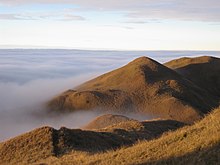
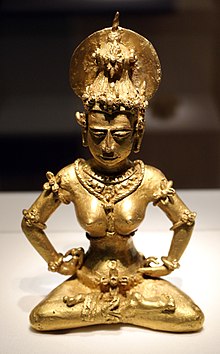
Indigenous Philippine folk religions, also referred to as Anitism, are a diverse group of native religions that have existed in the islands as the people's original faiths. Each possess their own set of belief systems and religious stories and narratives, mostly originating from beliefs held during the pre-Hispanic era, although many are also modern. Some of these beliefs have been influenced by Hinduism and Buddhism and were falsely regarded by the Spanish and American colonizers as "myths" and "superstitions" in an effort to de-legitimize the precolonial beliefs of Filipinos against Filipinos. Today, some of these native beliefs are still held by many Filipinos, both in urban and rural areas.
These religions tell the story of various narratives originating from various sources, having similarities with Indonesian and Malay religious narratives, as well as Hindu, Muslim, Buddhist, and Christian traditions. Beliefs include the notions of heaven (kaluwalhatian, kalangitan, kamurawayan, etc.), hell (kasamaan, sulad, etc.), and the human soul (kaluluwa, kaulolan, etc.). They explain the nature of the world through the lives and actions of deities (gods, goddesses), heroes, and other beings. The majority of these religious narratives are passed on through oral tradition, and preserved through the aid of community spiritual leaders or shamans (babaylan, katalonan, mumbaki, baglan, machanitu, walian, mangubat, bahasa, etc.) and community elders.
Today, many ethnic peoples continue to practice and conserve their unique indigenous religions, notably in ancestral domains, although foreign and foreign-inspired Hispanic and Arabic religions continue to interfere with their life-ways through conversions, land-grabbing, inter-marriage, and/or land-buying. Various scholarly works have been made regarding Anitism and its many religious aspects, although much of its stories and traditions are still undocumented by the international community.
The 2020 census recorded 0.23% of the population adhering to the Indigenous Philippine folk religions, an increase from the previous 2010 census which notes a 0.19% adherence.
Revitalization attempts
In search of a national culture and identity, away from those imposed by Spain during the colonial age, Filipino revolutionaries during the Philippine revolution proposed to revive the indigenous Philippine folk religions and make them the national religion of the entire country. The Katipunan opposed the religious teachings of the Spanish friars, saying that they "obscured rather than explained religious truths." After the revival of the Katipunan during the Spanish–American War, an idealized form of the folk religions was proposed by some, with the worship of God under the ancient name of Bathala, which applies to all supreme deities under the many ethnic pantheons in the Philippines.
Irreligion
Main article: Irreligion in the PhilippinesBased on the 2020 Census, the Philippine Statistics Authority reported the number of irreligious at less than 0.1% of the Philippine population.
The Philippine Atheists and Agnostics Society (PATAS) is a nonprofit organization for the public understanding of atheism and agnosticism in the Philippines which educates society, and eliminates myths and misconceptions about atheism and agnosticism. In February 2009, Filipino Freethinkers was formed. Since 2011, the Philippine Atheists and Agnostics Society has held its OUT Campaigns in Rizal Park and Quezon Memorial Circle. Also it held two feeding programs "Good without Religion" in Bacoor, Cavite. The society also is a member affiliate and associate of various international atheist organizations such as the Atheist Alliance International, Institute for Science and Human Values, and the International Humanist and Ethical Union, as one among secular organizations that promotes free thought and scientific development in the Philippines. The 2015 Philippine Census reported the religion of about 0.02% of the population as "none".
As of 2021, the Philippine Atheists and Agnostics Society is dormant and non-active, following a major internal scandal on finance matters.
Perception of religion during the COVID-19 pandemic

According to a 2020 survey by the Social Weather Stations (SWS), there had been a decline in the perception of importance in religion amidst the COVID-19 pandemic. According to the survey, 73 percent of Filipino adults deemed religion as important, which fell by 10 points compared to the pre-pandemic December 2019 survey which stated 83 percent believed religion is important in their lives.
Christianity, especially Catholicism, received a significant decline from 84 percent to 71 percent; other Christian denominations, except the Iglesia ni Cristo, fell from 78 percent to 71 percent. Iglesia ni Cristo, meanwhile, increased from 69 percent to 88 percent. In terms of Islam, it fell from 94 percent to 93 percent as "very important", almost receiving no change.
The 2020 SWS survey stated that Mindanao had a huge number of respondents who viewed religion as important (88 percent), followed by Luzon and Metro Manila (70 percent each), with Visayas being the lowest (64 percent).
Religion and politics
Further information: Freedom of religion in the Philippines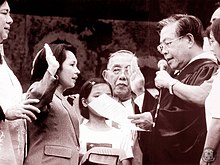
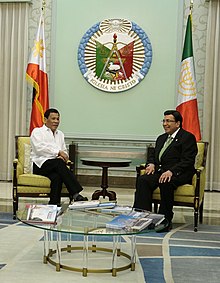
The 1987 Constitution of the Philippines declares: The separation of Church and State shall be inviolable. (Article II, Section 6), and, No law shall be made respecting an establishment of religion, or prohibiting the free exercise thereof. The free exercise and enjoyment of religious profession and worship, without discrimination or preference, shall forever be allowed. No religious test shall be required for the exercise of civil or political rights. (Article III, Section 5). Joaquin Bernas, a Filipino Jesuit specializing in constitutional law, acknowledges that there were complex issues that were brought to court and numerous attempts to use the separation of Church and State against the Catholic Church, but he defends the statement, saying that "the fact that he tried to do it does not deny the validity of the separation of church and state".
On April 28, 2004, the Philippines Supreme Court reversed the ruling of a lower court ordering five religious leaders to refrain from endorsing a candidate for elective office. Manila Judge Conception Alarcon-Vergara had ruled that the "head of a religious organization who influences or threatens to punish members could be held liable for coercion and violation of citizen's right to vote freely". The lawsuit filed that "the Church's active participation in partisan politics, using the awesome voting strength of its faithful flock, will enable it to elect men to public office who will in turn be forever beholden to its leaders, enabling them to control the government".
They claimed that this violates the Philippine constitution's separation of Church and State clause. The named respondents were the Archbishop of Manila Cardinal Luis Antonio Tagle, El Shaddai Movement Leader Mike Velarde, Iglesia ni Cristo Executive Minister Eduardo V. Manalo and Jesus Is Lord Church Worldwide leader Eddie Villanueva. Manalo's Iglesia ni Cristo practices bloc voting. Former Catholic Archbishop Cardinal Jaime Sin had been instrumental in rallying support for the assumption to power of Corazon Aquino and Gloria Arroyo. Velarde supported Fidel V. Ramos, Joseph Estrada, Gloria Macapagal Arroyo and Benigno Aquino III while Villanueva endorsed Fidel Ramos and Jose De Venecia. The papal nuncio agreed with the decision of the lower court while the other respondents challenged the decision.
See also
Notes
- ^ excluding Catholic Charismatic numbering 74,096 persons (0.07%)
References
- ^ "Religious Affiliation in the Philippines (2020 Census of Population and Housing)". Philippines in Figures. Quezon City, Philippines: Philippine Statistics Authority. February 22, 2023. Retrieved March 25, 2023. Finer details can be found in the Statistical Tables on the web page
- ^ "The World Factbook - Central Intelligence Agency". Retrieved January 19, 2012.
- ^ Pew Research Center's Religion & Public Life Project: Philippines Archived July 8, 2014, at the Wayback Machine. Pew Research Center. 2010.
- ^ Mapa, Dennis S. (February 22, 2023). "Religious Affiliation in the Philippines (2020 Census of Population and Housing)". Philippine Statistics Authority (Press release). Archived from the original on March 10, 2023. Retrieved March 12, 2023.
- "Buddhism in Philippines, Guide to Philippines Buddhism, Introduction to Philippines Buddhism, Philippines Buddhism Travel". Archived from the original on August 20, 2007.
- "Philippines – Pew-Templeton Global Religious Futures Project". Archived from the original on July 8, 2014. Retrieved June 18, 2014.
- "Punjabi Community Involved in Money Lending in Philippines Braces for 'Crackdown' by New President". May 18, 2016.
- "2011 Gurdwara Philippines: Sikh Population of the Philippines". Archived from the original on December 1, 2011. Retrieved June 11, 2011.
- Bullivant, Stephen; Ruse, Michael, eds. (November 21, 2013). The Oxford Handbook of Atheism. Oxford, England: OUP Oxford. p. 563. ISBN 978-0-19-166739-8. Retrieved September 2, 2020.
- Martin, Michael, ed. (October 30, 2006). The Cambridge Companion to Atheism. Cambridge, England: Cambridge University Press. p. 61. ISBN 978-1-139-82739-3. Retrieved February 18, 2023.
- "Philippine Church National Summary". philchal.org. Archived from the original on September 17, 2017. Retrieved September 17, 2017.
- "500 years of Protestantism (World Christian Database)" (PDF). Archived (PDF) from the original on February 18, 2017.
- RP closer to becoming observer-state in Organization of Islamic Conference Archived June 3, 2016, at the Wayback Machine. (May 29, 2009). The Philippine Star. Retrieved 2009-07-10, "Eight million Muslim Filipinos, representing 10 percent of the total Philippine population, ...".
- McAmis, Robert Day (2002). Malay Muslims: The History and Challenge of Resurgent Islam in Southeast Asia. Wm. B. Eerdmans Publishing. pp. 18–24, 53–61. ISBN 0-8028-4945-8. Retrieved January 7, 2010.
- ^ R Michael Feener; Terenjit Sevea (2009). Islamic Connections: Muslim Societies in South and Southeast Asia. Institute of Southeast Asian Studies. p. 144. ISBN 9789812309235. Retrieved June 7, 2014.
- Article III, Section 5 of the Constitution of the Philippines (1987)
- "Philippines: Freedom in the World 2024 Country Report". Freedom House.
- "The World Factbook — Central Intelligence Agency". Retrieved January 19, 2012.
- "Religion and Politics in the Philippine Setting". Center for Media Freedom and Responsibility. February 27, 2022. Retrieved October 9, 2024.
- ^ Aguilar, Filomeno Jr. (2015). "Church-State Relations in the 1899 Malolos Constitution: Filipinization and Visions of National Community". Southeast Asian Studies. 4 (2): 305. Retrieved October 9, 2024.
- Russel, Susan. "Christianity in the Philippines". Center for Southeast Asian Studies, Northern Illinois University. Retrieved July 14, 2020.
- "Cardinal says Pope understands his role in Philippines". The Calgary Herald. June 21, 1986. p. A11. Retrieved October 2, 2024.
- "Celebrating All Souls Day in the Philippines". barokandtakya.com/. October 31, 2020.
- Placido, ABS-CBN News, Dharel. "Duterte signs law declaring Dec. 8 a nationwide holiday". Archived from the original on March 9, 2018. Retrieved March 22, 2018.
- "Anglican Communion: Churches in Communion". Anglican Communion Website.
- "The Concordat of Full Communion Between the Iglesia Filipina Independiente and The Episcopal Church". The Episcopal Church. Retrieved November 10, 2022.
- Cabillas, Dionito M. (July 3, 2002). "Iglesia Filipina Independiente (Philippine Independent Church) (IFI). (Comments from Churches Involved in Union Negotiations)". Gale Academic OneFile. 54 (3). The Ecumenical Review, vol. 54, no. 3, pp. 414+: 414–420. Retrieved November 1, 2022.
- "Iglesia ni Kristo". Encyclopædia Britannica Online. Encyclopædia Britannica. 2008. Archived from the original on January 7, 2009. Retrieved November 5, 2008.
- Sanders, Albert J., "An Appraisal of the Iglesia ni Cristo," in Studies in Philippine Church History, ed. Anderson, Gerald H. (Cornell University Press, 1969)
- Bevans, Stephen B.; Schroeder, Roger G. (2004). Constants in Context: A Theology of Mission for Today (American Society of Missiology Series). Orbis Books. p. 269. ISBN 1-57075-517-5.
- Carnes, Tony; Yang, Fenggang (2004). Asian American religions: the making and remaking of borders and boundaries. New York: New York University Press. p. 352. ISBN 978-0-8147-1630-4.
- Kwiatkowski, Lynn M. (October 1999). Struggling With Development: The Politics Of Hunger And Gender In The Philippines. Westview Press. p. 286. ISBN 978-0-8133-3784-5.
- Palafox, Quennie Ann J. 'First Executive Minister of the Iglesia ni Cristo (Church of Christ)' Archived February 13, 2012, at the Wayback Machine "National Historical Institute"
- "I.N.C. holds 19 simultaneous grand evangelical missions nationwide". BusinessMirror. April 2, 2012. Archived from the original on December 4, 2014. Retrieved November 13, 2015.
- "Lingap Sa Mamamayan | Iglesia Ni Cristo Media". incmedia.org. Archived from the original on November 16, 2015. Retrieved November 13, 2015.
- "Fact sheet: INC resettlement and eco-farming site". Eagle News. March 14, 2014. Archived from the original on November 17, 2015. Retrieved November 13, 2015.
- "The Iglesia ni Cristo Controversy Now Includes Names and a Libel Case".
- Punay, Edu (November 3, 2015). "Iglesia Ni Cristo seeks dismissal of kidnap, illegal detention raps". The Philippine Star. Retrieved July 14, 2023.
- "Philippine Christian group ends protest blocking Manila highway". Reuters. August 30, 2015. Retrieved July 14, 2023.
- "After the 2015 controversies: What's been happening inside the Iglesia ni Cristo?". July 27, 2019.
- "Religious Affiliation in the Philippines (2020 Census of Population and Housing)". psa.gov.ph. Retrieved October 9, 2024.
- "History - North Philippine Union Conference of the Seventh-day Adventist Church". August 1, 2024. Retrieved October 9, 2024.
- Philippines Archived July 24, 2011, at the Wayback Machine, Adventist Atlas Archived June 22, 2011, at the Wayback Machine
- "Southern Asia-Pacific Division". Adventiststatistics.org. Retrieved October 9, 2024.
- "Educational Institutions in Philippines - Adventist Organizational Directory". www.adventistdirectory.org. Retrieved October 9, 2024.
- "More 'souls' baptized by Jesus Miracle Crusade". The Mindanao Examiner. April 29, 2016. Retrieved May 4, 2023 – via PressReader.
- Chia, Edmund Kee-Fook (August 19, 2021). Asian Christianity and Theology: Inculturation, Interreligious Dialogue, Integral Liberation. Routledge. ISBN 978-1-000-42504-8. Retrieved May 4, 2023.
- "Philippine Red Cross". Archived from the original on December 21, 2012. Retrieved March 4, 2013.
- "Religions in the Philippines". pinoysites.org. Retrieved March 7, 2007.
- "Religions in the Philippines". philippine-directory.com. Archived from the original on July 15, 2011. Retrieved April 7, 2007.
- ^ "TABLE A. Household Population by Religious Affiliation, Region, Province, and Highly Urbanized City: Philippines, 2020". Philippine Statistics Authority. Archived from the original on March 15, 2023. Retrieved May 4, 2023.
- "Apostolic church patriarch and founding bishop". The Manila Times. July 31, 2021. Retrieved October 25, 2022.
- "Our Member Churches". Retrieved October 25, 2022.
- "Our Member Churches". Retrieved March 30, 2022.
- "Orthodox Christians in Philippines". Orthodox Church in the Philippines. Archived from the original on September 30, 2007. Retrieved August 2, 2007.
- Article Provided By Rev. Philemon Castro. "The Orthodox Church In The Philippines". Dimitris Papadias, Professor at the Department of Computer Science and Engineering, Hong Kong. Archived from the original on October 7, 1999.
- "500 years of Protestantism" (PDF). 500 years of Protestantism. Archived from the original (PDF) on January 8, 2019.
- "Table: Christian Population as Percentages of Total Population by Country". Pew Research. December 19, 2011.
- "Union Espiritista Cristiana de Filipinas, Inc". Archived from the original on February 4, 2014. Retrieved May 9, 2014.
- "Philippines Episcopal Areas".
- "News of the Church: New Temple Announcement Answers Members' Prayers". Liahona. September 2006. Retrieved November 23, 2008.
- "Facts and Statistics – Philippines". Newsroom – The Church of Jesus Christ of the Latter-day Saints. Retrieved July 22, 2020.
- "Temples in the Philippines". ph.churchofjesuschrist.org.
- https://churchofjesuschristtemples.org/maps/temples/
- 2003 Yearbook of Jehovah's Witnesses, p.154
- Awake! January 8, 1994, p.22
- G.R. No. 95770 March 1, 1993 Archived January 1, 2015, at the Wayback Machine. Chanrobles.com. Retrieved on March 27, 2012.
- "2021 Service Year Report of Jehovah's Witnesses Worldwide". Watch Tower Society.
- Laforteza, Elaine Marie Carbonell (2016). The Somatechnics of Whiteness and Race: Colonialism and Mestiza Privilege. Routledge. pp. 35–36. ISBN 978-1-317-01516-1.
- "Philippines". Retrieved May 24, 2018.
- O'Shaughnessy, Thomas J (1975). "How Many Muslims Has the Philippines?". Philippine Studies. 23 (3): 375–382. JSTOR 42632278.
- RP closer to becoming observer-state in Organization of Islamic Conference Archived June 3, 2016, at the Wayback Machine. (May 29, 2009).The Philippine Star. Retrieved 2009-07-10, "Eight million Muslim Filipinos, representing 10 percent of the total Philippine population, ...".
- Hassall, Graham; Austria, Orwin (January 2000). "Mirza Hossein R. Touty: First Baháʼí known to have lived in the Philippines". Essays in Biography. Asia Pacific Baháʼí Studies. Archived from the original on August 5, 2011. Retrieved June 1, 2008.
- Effendi, Shoghi (1944). God Passes By. Wilmette, Illinois, USA: Baháʼí Publishing Trust. ISBN 0-87743-020-9. Archived from the original on May 12, 2008. Retrieved June 6, 2008.
- Universal House of Justice (1986). "Part Five: In Memoriam". The Baháʼí World. Vol. 18. Baháʼí World Centre. Table of Contents and pp.513, 652–9. ISBN 0-85398-234-1. Archived from the original on May 17, 2004. Retrieved June 6, 2008.
- "QuickLists: Most Baha'i Nations (2010)". Association of Religion Data Archives. 2010. Archived from the original on March 2, 2021. Retrieved October 15, 2020.
- ^ Philippines Jewish Community Archived December 24, 2009, at the Wayback Machine, Jewish Times Asia (May 2006), pp.12–13. Retrieved on July 16, 2019.
- Della Pergola, Sergio (2018). "World Jewish Population, 2018" (PDF). Berman Jewish DataBank. American Jewish Year Book 2018. p. 53. Retrieved July 16, 2019.
- Schlossberger, E. Cauliflower and Ketchup Archived July 29, 2009, at the Wayback Machine.
- Virgilio S. Almario, UP Diksunaryong Filipino
- Khatnani, Sunita (October 11, 2009). "The Indian in the Filipino". Philippine Daily Inquirer. Archived from the original on June 21, 2015. Retrieved August 12, 2015.
- Jesus Peralta, "Prehistoric Gold Ornaments CB Philippines," Arts of Asia, 1981, 4:54–60
- Art Exhibit: Philippines' 'Gold of Ancestors' Archived March 4, 2016, at the Wayback Machine in Newsweek.
- Laszlo Legeza, "Tantric Elements in Pre-Hispanic Gold Art," Arts of Asia, 1988, 4:129–133.
- Camperspoint: History of Palawan Archived January 15, 2009, at the Wayback Machine. Accessed August 27, 2008.
- filipinobuddhism (November 8, 2014). "Early Buddhism in the Philippines". Archived from the original on December 22, 2015. Retrieved December 16, 2015.
- "TABLE A. Household Population by Religious Affiliation, Region, Province, and Highly Urbanized City: Philippines, 2020". Philippine Statistics Authority. February 2, 2023. Retrieved October 9, 2024.
- "The International Day of Vesak | Philippines".
- "Home". Hokaiji Temple.
- Yu, Jose Vidamor B. (2000). Inculturation of Filipino-Chinese Culture Mentality. Gregorian Biblical BookShop. pp. 87–88. ISBN 978-88-7652-848-4. Retrieved July 25, 2020.
- "History of Buddhism". Buddhism in the Philippines. Archived from the original on August 20, 2008. Retrieved March 16, 2008.
- Thakur, Upendra (1986). Some Aspects of Asia and Culture. Abhinav Publications.
- Anna T. N. Bennett (2009), "Gold in early Southeast Asia" Archived May 14, 2015, at the Wayback Machine, ArcheoSciences, Volume 33, pp 99–107
- Dang V.T. and Vu, Q.H., 1977. "The excavation at Giong Ca Vo site." Journal of Southeast Asian Archaeology 17: 30–37
- "Philippines, Religion And Social Profile". thearda.com. Retrieved June 25, 2024.
- ^ "ANITISM AND PERICHORESIS: TOWARDS A FILIPINO CHRISTIAN ECO-THEOLOGY OF NATURE". elibrary.ru. Retrieved December 28, 2019.
- Almocera, Reuel (May 28, 1990). "Christianity encounters Filipino spirited-world beliefs: a case study". Archived from the original on March 27, 2019. Retrieved June 4, 2019 – via dspace.aiias.edu.
- Hislop, Stephen K. "ANITISM: A SURVEY OF RELIGIOUS BELIEFS NATIVE TO THE PHILIPPINES" (PDF). Asian Studies: 144–156.
- "Download Karl Gaverza's Incredible Philippine Mythology Thesis". April 22, 2018.
- Almocera, Reuel (May 1, 1990). "Christianity encounters Filipino spirited-world beliefs: a case study". Archived from the original on March 27, 2019. Retrieved June 4, 2019 – via dspace.aiias.edu.
- ^ "Table 1.10; Household Population by Religious Affiliation and by Sex; 2010" (PDF). 2015 Philippine Statistical Yearbook. East Avenue, Diliman, Quezon City, Philippines: Philippine Statistics Authority: 1–30. October 2015. ISSN 0118-1564. Archived (PDF) from the original on October 11, 2016. Retrieved July 14, 2020.
- L. W. V. Kennon (August 1901). "The Katipunan of the Philippines". The North American Review. 17 (537). University of Northern Iowa: 211, 214. JSTOR 25105201.
- "Agnosticism and Atheism in the Philippines". The Free Thinker. Archived from the original on May 1, 2011. Retrieved April 28, 2011.
- "Filipino Freethinkers Official Website". Archived from the original on July 6, 2011. Retrieved August 20, 2009.
- Catholic Philippines gains its first atheist society Archived July 1, 2011, at the Wayback Machine. Freethinker.co.uk. Retrieved on March 27, 2012.
- Kevin Enriquez (December 17, 2015). "Humanism in the Philippines". Young Humanists International.
- ^ Lalu, Gabriel Pabico. "SWS: Number of Filipinos who think religion is 'very important' drops from 83% to 73%". Retrieved October 9, 2024.
- Joaquin G. Bernas (1995). The Intent of the 1986 Constitution Writers. Published & distributed by Rex Book Store. p. 86. ISBN 9789712319341.
- Tubeza, Philip C.; Avendaño, Christine O. (May 1, 2004). "High court gives gives go-ahead for religious endorsement". Philippine Daily Inquirer. p. A1, A21. Retrieved October 9, 2024.
- Velarde vs Social Justice Society : 159357 : April 28, 2004 : J. Panganiban : En Banc : Decision Archived April 1, 2012, at the Wayback Machine. Sc.judiciary.gov.ph. Retrieved on March 27, 2012.
- No role for Church in politics. Manila Standard. June 22, 2003
- Philip C. Tubeza Iglesia appeals court ruling infringing on group's belief. Philippine Daily Inquirer. July 20, 2003
- SC ruling sought on sect's vote. Philippine Daily Inquirer. April 1, 2004
External links
 Media related to Religion in the Philippines at Wikimedia Commons
Media related to Religion in the Philippines at Wikimedia Commons
| Philippines articles | |||||||
|---|---|---|---|---|---|---|---|
| History |
| ||||||
| Geography | |||||||
| Politics |
| ||||||
| Economy | |||||||
| Society |
| ||||||
| Religion in Asia | |
|---|---|
| Sovereign states |
|
| States with limited recognition | |
| Dependencies and other territories | |